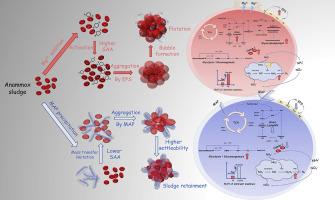Mg²⁺ and magnesium ammonium phosphate (MAP)-induced anammox granulation for comparable nitrogen removal: Implementation pathways and microbial mechanisms
IF 12.4
1区 环境科学与生态学
Q1 ENGINEERING, ENVIRONMENTAL
引用次数: 0
Abstract
Anaerobic ammonium oxidation (anammox) process is a highly effective and economic technology for nitrogen removal from wastewater. However, the slow growth of anammox bacteria and sludge flotation often hinder its field application. Ion adsorption and crystal precipitation can potentially promote the sludge granulation and hence address the above issues. This study investigated two approaches to support anammox granulation through Mg2+ adsorption and magnesium ammonium phosphate (MAP) precipitation. Mg2+ addition improved the specific anammox activity (SAA) by 4.09 to 4.75-fold compared to MAP-mediated ones, which could be explained by the upregulations of nitrogen and inorganic carbon metabolisms. The active extracellular polymeric substances generation at metabolites level may also favor the granulation in Mg2+-mediated anammox. However, sludge loss halted the continuous size increase of sludge. Differently, MAP promoted granulation by physically increasing the granular density, which allowed for a greater retention of sludge within the reactor. However, the co-growth of MAP precipitates with anammox may lead to mass transfer limitations, resulting in down-regulated gene expressions and metabolites in inorganic carbon metabolism, which negatively impacted the SAA. Overall, both strategies achieved comparable nitrogen removal capacities. Nevertheless, the co-growth of MAP and anammox was promising for effectively mitigating sludge flotation. Our study provided strategies and omics-based evidences for anammox granulation and activity variations, benefiting anammox practical applications.


Mg 2 +和磷酸铵镁(MAP)诱导的厌氧氨氧化造粒用于可比的脱氮:实现途径和微生物机制
厌氧氨氧化法(anammox)是一种高效、经济的污水脱氮技术。但厌氧氨氧化菌生长缓慢和污泥浮选等问题往往阻碍其在现场的应用。离子吸附和结晶沉淀可以潜在地促进污泥造粒,从而解决上述问题。研究了Mg2+吸附和磷酸铵镁(MAP)沉淀两种支持厌氧氨氧化制粒的方法。Mg2+的添加使特定厌氧氨氧化活性(SAA)提高了4.09 ~ 4.75倍,这可能与添加Mg2+上调了氮素和无机碳代谢有关。代谢水平上胞外聚合物质的活性生成也可能有利于Mg2+介导的厌氧氨氧化的肉芽化。然而,污泥的损失阻止了污泥粒径的持续增加。不同的是,MAP通过物理增加颗粒密度来促进造粒,这允许在反应器内保留更大的污泥。然而,MAP沉淀物与厌氧氨氧化共生可能导致传质受限,导致无机碳代谢中的基因表达和代谢物下调,对SAA产生负面影响。总的来说,这两种策略都达到了相当的脱氮能力。尽管如此,MAP和厌氧氨氧化菌的共同生长有望有效缓解污泥浮选。本研究为厌氧氨氧化制粒和活性变化提供了策略和组学依据,有利于厌氧氨氧化的实际应用。
本文章由计算机程序翻译,如有差异,请以英文原文为准。
求助全文
约1分钟内获得全文
求助全文
来源期刊

Water Research
环境科学-工程:环境
CiteScore
20.80
自引率
9.40%
发文量
1307
审稿时长
38 days
期刊介绍:
Water Research, along with its open access companion journal Water Research X, serves as a platform for publishing original research papers covering various aspects of the science and technology related to the anthropogenic water cycle, water quality, and its management worldwide. The audience targeted by the journal comprises biologists, chemical engineers, chemists, civil engineers, environmental engineers, limnologists, and microbiologists. The scope of the journal include:
•Treatment processes for water and wastewaters (municipal, agricultural, industrial, and on-site treatment), including resource recovery and residuals management;
•Urban hydrology including sewer systems, stormwater management, and green infrastructure;
•Drinking water treatment and distribution;
•Potable and non-potable water reuse;
•Sanitation, public health, and risk assessment;
•Anaerobic digestion, solid and hazardous waste management, including source characterization and the effects and control of leachates and gaseous emissions;
•Contaminants (chemical, microbial, anthropogenic particles such as nanoparticles or microplastics) and related water quality sensing, monitoring, fate, and assessment;
•Anthropogenic impacts on inland, tidal, coastal and urban waters, focusing on surface and ground waters, and point and non-point sources of pollution;
•Environmental restoration, linked to surface water, groundwater and groundwater remediation;
•Analysis of the interfaces between sediments and water, and between water and atmosphere, focusing specifically on anthropogenic impacts;
•Mathematical modelling, systems analysis, machine learning, and beneficial use of big data related to the anthropogenic water cycle;
•Socio-economic, policy, and regulations studies.
 求助内容:
求助内容: 应助结果提醒方式:
应助结果提醒方式:


